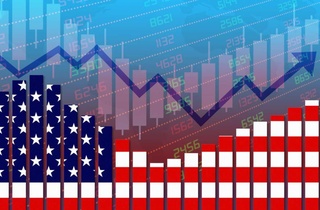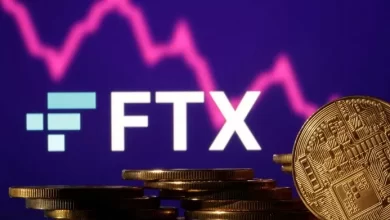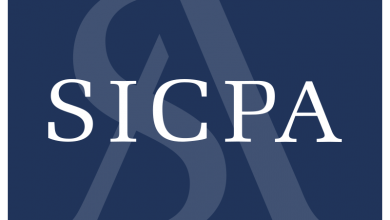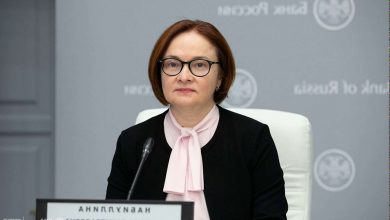
While the focus of investors was central banks, the intense macroeconomic calendar and balance sheets last week, the mixed signals received made it difficult for the markets to find direction.
HIGHEST LEVEL IN 16 YEARS
The US Federal Reserve (Fed), at its meeting during the week, increased the policy rate by 25 basis points, in line with the expectations, to the range of 5-5.25 percent, the highest level in 16 years. Realizing the 10th rate hike since March last year, the bank raised the interest rate by a total of 500 basis points.
In the statement made by the bank, it was pointed out that economic activity recorded a “moderate growth” in the first quarter, and it was stated that job gains have been strong in recent months, the unemployment rate has remained low and inflation has remained high.
It was noteworthy that the statement “it is foreseen that some additional policy tightening may be appropriate to achieve a sufficiently restrictive stance” was removed from the explanation.
WILL THE FED END THE INCREASED?
Analysts reminded that it was considered certain that the bank would stop the rate hike in June in the pricing in money markets, but Fed Chairman Jerome Powell said at the press conference he held after the interest rate decision that whether to stop the interest rate hikes would be discussed at the June meeting.
According to the data released in the country last week, analysts stated that the strong course of the labor market continues and noted that the said data relieved the Fed’s hand regarding the policy area.
While non-farm employment in the USA increased by 253 thousand people in April, exceeding expectations, the unemployment rate fell to 3.4 percent, the lowest level in more than 50 years.
On the other hand, the banking crisis, which subsided after the US Federal Deposit Insurance Corporation (FDIC) announced that the First Republic Bank was closed and its assets would be acquired by one of the largest US banks, JPMorgan Chase, took effect again in the US this week, but government officials and banks were asked to pay attention. The statements made increased the volatility in regional bank stocks.
After Pacwest, one of the banks in question, announced that it was evaluating its options, including the sale of strategic assets, and that negotiations with potential investors and partners who showed interest in the last period, the wave lengths of the bank’s shares increased and transactions were stopped many times due to high volatility.
After all these developments, the US 10-year bond interest rate fluctuated by about 30 basis points during the week, and ended the week at 3.44 percent with an increase of approximately 2 basis points. The dollar index, which followed a downward trend, closed the week at 101.2, about 0.5 percent below its previous closing.
While the price of gold tested the highest level since March 2022 at $2,065.4 during the week, it closed the week at $2,016.9, an increase of 1.4 percent compared to the previous close.
Brent oil, which carried the downward trend for the third week in a row, closed the week at $75.2 with a decrease of 6.2 percent, after the barrel price of Brent oil fell to the lowest level of the last year with $71.5.
NEW YORK EXCHANGES WATCHED MIXED TRACKS
While the US stock markets followed a mixed course during the Fed week, the inflation data to be announced on Wednesday next week placed the focus of investors.
Analysts stated that it is considered certain that the Fed will stop the rate hike in June, in the pricing in the money markets, and that the Bank is priced to cut interest rates by 50 basis points by the end of the year, but Powell’s questions on the subject at the meeting, “We can’t think of a rate cut right now.” He reminded me that he replied.
Analysts stated that the macroeconomic data in the country will continue to be followed closely, and that the inflation data to be announced in the USA next week and the verbal guidance of the Fed officials will play an important role in shaping the expectations for the next period.
In the US, the Consumer Price Index (CPI) is expected to increase by 0.4 percent monthly and 5 percent annually in April.
On the other hand, while the discussions regarding the debt limit impasse in the USA remained warm, it was reported in the news in the country that the White House evaluated the short-term increase in the debt limit.
Macroeconomic data announced in the country continued to give mixed signals. Accordingly, although the Supply Management Institute (ISM) manufacturing index exceeded the market expectations with 47.1 in April, the contraction in the manufacturing industry continued, while the ISM non-manufacturing index in the country increased by 0.7 points on a monthly basis to 51.9 in the same period. exceeded.
While the Number of JOLTS Vacancies fell to 9 million 590 thousand in March with a decrease of 384 thousand compared to the previous month, the number of vacancies, which fell below the market projections, fell to the lowest level since April 2021. Factory orders in the country were also below expectations with an increase of 0.9 percent in March.
According to the data released last week, while private sector employment in the USA increased by 296 thousand people in April, above the market forecasts, although the revenues of technology giant Apple, one of the technology giants, decreased by 3 percent in the January-March period to 94.8 billion dollars in the ongoing balance sheet season in the country, the market exceeding the forecasts eroded the risk perception.
With these developments, the S&P 500 fell by 0.8 percent and the Dow Jones index by 1.2 percent in the New York stock market last week, while the Nasdaq index rose by 0.1 percent.
The data calendar for the week starting May 8 will track wholesale sales on Monday, Producer Price Index (PPI) and weekly unemployment on Thursday, and Michigan consumer confidence index data on Friday.
EYES LOOK AT BOE IN EUROPE
In the European stock markets, a mixed course was observed in the week when the European Central Bank (ECB) increased the three main policy rates by 25 basis points in line with the expectations, while the monetary policy decisions of the Bank of England (BoE) for the next week were placed in the focus of the investors.
In the statement made by the ECB, it was announced that the decisions to be taken in the coming period will tighten the markets sufficiently, while ECB President Christine Lagarde, who made statements after the meeting, said that the bank has “more way to go” against inflation and that it does not “stop” monetary tightening to combat inflation in the Eurozone. .
Analysts said that after these developments, the ECB is predicted to increase interest rates by 50 basis points until the end of the year in pricing in money markets.
On the other hand, BoE is expected to increase the policy rate by 25 basis points on Thursday next week.
While the manufacturing industry Purchasing Managers Index (PMI) data released in the region last week pointed out that the contraction in the manufacturing industry continues, concerns about economic activity are getting stronger day by day.
Retail sales in the euro area and Germany fell 1.2 and 2.4 percent in March, respectively, compared to the previous month, below expectations.
The Producer Price Index (PPI), in the euro area, decreased by 1.6 percent on a monthly basis in March, in line with the projections, and increased by 5.9 percent on an annual basis. Unemployment rate in the region decreased from 6.6 percent to 6.5 percent in March.
Factory orders in Germany, which fell by 10.7 percent month-on-month in March, below the expectations, recorded the biggest monthly decrease after April 2020.
According to data released last week, German exports fell 5.2 percent in March amid weaker demand from Europe and the United States, following higher inflation and higher interest rates, despite easing supply chain problems.
On the other hand, the euro/dollar parity, which is close to the peak of the last 1 year, closed the week at 1.1019, just above its previous close.
With these developments, the CAC 40 index in France and the FTSE 100 index in the UK depreciated by 1.2 percent and the FTSE 100 index in the UK decreased by 1.7 percent, while the DAX index in Germany increased by 0.2 percent and the MIB 30 index in Italy increased by 1 percent. .
Next week, industrial production in Germany on Monday, subject price index in England on Tuesday, inflation in Germany on Wednesday, BoE interest rate decision in England on Thursday, growth and industrial production data will be followed.
ASIA FOCUS ON CHINA’S INFLATION DATA
While a buying-heavy trend was prominent in Asian stock markets last week, the central banks of the countries in the region, which announced their interest rate decisions, followed the Fed and increased by 25 basis points.
While central banks’ monetary policy decisions came to the fore in Asia last week, the Reserve Bank of Australia (RBA), contrary to expectations, increased the policy rate by 25 basis points to 3.85 percent. In the statement made by the bank, it was announced that it would continue to increase interest rates if necessary.
Hong Kong Monetary Authority (HKMA), the de facto central bank, announced that the benchmark interest rate was increased by 25 basis points to 5.5 percent.
While the HKMA bought 4,671 billion Hong Kong dollars (approximately 595.1 million dollars) from the international market in order to prevent the currency depreciation against the US dollar following the interest rate hike, it was the 50th time since the Fed’s interest rate hikes began in March 2022. It is stated that it aims to keep the Kong dollar-US dollar parity between 7.75 and 7.85.
On the other hand, CPI in China, which will be announced next week, is expected to increase by 1 percent annually in April.
According to the data released in the region last week, although the service sector PMI in China declined to 56.4, it was pointed out that the expansion continued, while the manufacturing industry PMI remained below the expectations with 49.5, signaling that the contraction in industrial production has started.
Analysts stated that despite the continuing concerns about the Chinese economy, the expectations that monetary and fiscal policies can be used in a supportive way support the risk appetite.
The Nikkei 225 index in Japan, which was open only in the first 2 trading days this week due to the holidays, gained 1.04 percent on a weekly basis, while the Shanghai composite index in China, which was traded for 3 days, closed the week with an increase of 0.34 percent.
While the Kospi index in South Korea completed the week just below its previous closing, the Hang Seng index in Hong Kong finished the week with an increase of 0.78 percent.
In the data calendar of the week that started with May 8, the services sector PMI in Japan on Monday, the foreign trade surplus in China on Tuesday, the leading index in Japan on Wednesday, the current account balance in Japan on Thursday, the CPI and PPI data in China will be followed.
Inflation fell to 43.68 percent on an annual basis in April, the lowest level in 16 months.
While the BIST 100 index, which carried the downward trend in the domestic market for the third week in a row, closed at 4,400.76 points with a 4.7 percent depreciation, eyes were turned to industrial production data for the next week.
In the summary of the meeting of the Monetary Policy Committee of the Central Bank of the Republic of Turkey (CBRT) on April 27, it was stated that “in line with the goal of sustainable price stability in monetary policy, a liraization-oriented approach that also takes into account the risks to financial stability will continue.”
This week, the Capital Markets Board (CMB) approved the public offering application of Bien Yapı Ürünleri Sanayi Turizm ve Ticaret AŞ for 42.8 liras and Kayseri Şeker Fabrikası AŞ for 16.27 liras.
In addition, as a result of the examination carried out regarding the transactions carried out in Borsa İstanbul AŞ markets, the CMB has declared to JP Morgan Securities PLC for “contrary to clauses a, b, d, e and f of the first paragraph of Article 5 of the Communique on Market Distorting Actions No. VI-104.1”. He imposed an administrative fine of 32 million 795 thousand 908 liras.
According to the domestic data released last week, inflation increased by 2.39 percent on a monthly basis in April and fell to 43.68 percent, the lowest level in 16 months, on an annual basis. Manufacturing PMI was 51.5.
HOW DOLLAR TL CLOSED THE WEEK?
Dollar/TL closed the week at 19.5033, 0.3 percent above the previous weekly close.
Analysts said that in the BIST 100 index, technically, 4.300 and 4.200 levels can stand out as support and 4.500 and 4.600 points as resistance.
Next week, domestic treasury balance on Monday, industrial production and unemployment rate on Wednesday, weekly money and bank statistics on Thursday and retail sales data on Friday will be followed.















